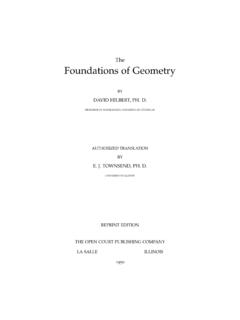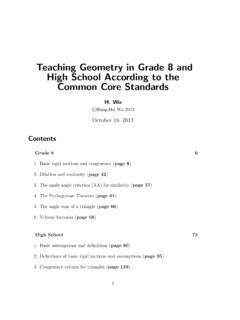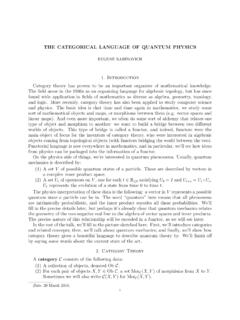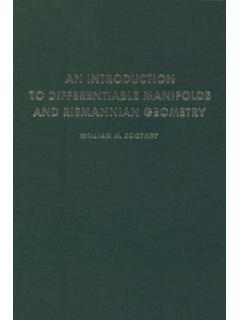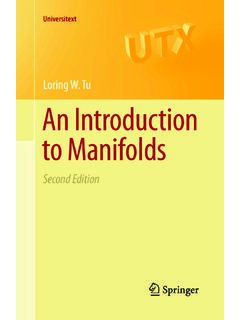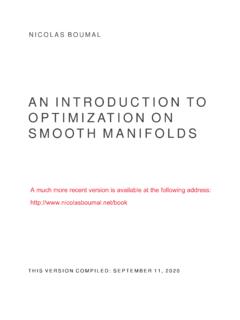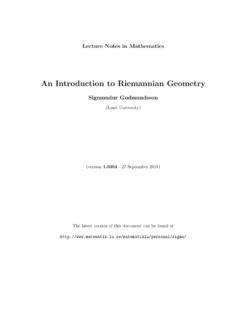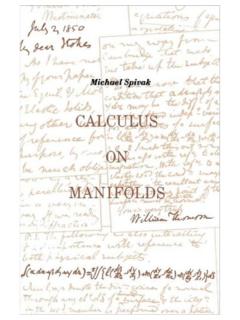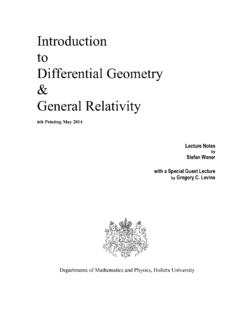Transcription of Graduate Texts in Mathematics 218
1 Graduate Texts in Mathematics218 Graduate Texts in MathematicsSeries Editors:Sheldon AxlerSan Francisco State University, San Francisco, CA, USAK enneth RibetUniversity of California, Berkeley, CA, USAA dvisory Board:Colin Adams, Williams College, Williamstown, MA, USAA lejandro Adem, University of British Columbia, Vancouver, BC, CanadaRuth Charney, Brandeis University, Waltham, MA, USAI rene M. Gamba, The University of Texas at Austin, Austin, TX, USAR oger E. Howe, Yale University, New Haven, CT, USAD avid Jerison, Massachusetts Institute of Technology, Cambridge, MA, USAJ effrey C. Lagarias, University of Michigan, Ann Arbor, MI, USAJill Pipher, Brown University, Providence, RI, USAF adil Santosa, University of Minnesota, Minneapolis, MN, USAAmie Wilkinson, University of Chicago, Chicago, IL, USAG raduate Texts in Mathematicsbridge the gap between passive study and creativeunderstanding, offering Graduate -level introductions to advanced topics in mathe-matics.
2 The volumes are carefully written as teaching aids and highlight character-istic features of the theory. Although these books are frequently used as textbooksin Graduate courses, they are also suitable for individual further M. LeeIntroduction toSmooth ManifoldsSecond EditionJohn M. LeeDepartment of MathematicsUniversity of WashingtonSeattle, WA, USAISSN 0072-5285 ISBN 978-1-4419-9981-8 ISBN 978-1-4419-9982-5 (eBook)DOI New York Heidelberg Dordrecht LondonLibrary of Congress Control Number: 2012945172 Mathematics Subject Classification: 53-01, 58-01, 57-01 Springer Science+Business Media New York 2003, 2013 This work is subject to copyright.
3 All rights are reserved by the Publisher, whether the whole or part ofthe material is concerned, specifically the rights of translation, reprinting, reuse of illustrations, recitation,broadcasting, reproduction on microfilms or in any other physical way, and transmission or informationstorage and retrieval, electronic adaptation, computer software, or by similar or dissimilar methodologynow known or hereafter developed. Exempted from this legal reservation are brief excerpts in connectionwith reviews or scholarly analysis or material supplied specifically for the purpose of being enteredand executed on a computer system, for exclusive use by the purchaser of the work.
4 Duplication ofthis publication or parts thereof is permitted only under the provisions of the Copyright Law of thePublisher s location, in its current version, and permission for use must always be obtained from for use may be obtained through RightsLink at the Copyright Clearance Center. Violationsare liable to prosecution under the respective Copyright use of general descriptive names, registered names, trademarks, service marks, etc. in this publicationdoes not imply, even in the absence of a specific statement, that such names are exempt from the relevantprotective laws and regulations and therefore free for general the advice and information in this book are believed to be true and accurate at the date of pub-lication, neither the authors nor the editors nor the publisher can accept any legal responsibility for anyerrors or omissions that may be made.
5 The publisher makes no warranty, express or implied, with respectto the material contained on acid-free paperSpringer is part of Springer Science+Business Media ( )PrefaceManifolds crop up everywhere in Mathematics . These generalizations of curves andsurfaces to arbitrarily many dimensions provide the mathematical context for un-derstanding space in all of its manifestations. Today, the tools of manifold theoryare indispensable in most major subfields of pure Mathematics , and are becomingincreasingly important in such diverse fields as genetics, robotics, econometrics,statistics, computer graphics, biomedical imaging, and, of course, the undisputedleader among consumers (and inspirers) of Mathematics theoretical physics.
6 Nolonger the province of differential geometers alone, smooth manifold technology isnow a basic skill that all Mathematics students should acquire as early as the past century or two, mathematicians have developed a wondrous collec-tion of conceptual machines that enable us to peer ever more deeply into the invisi-ble world of geometry in higher dimensions. Once their operation is mastered, thesepowerful machines enable us to think geometrically about the6-dimensional solu-tion set of a polynomial equation in four complex variables, or the10-dimensionalmanifold of5 5orthogonal matrices, as easily as we think about the familiar2-dimensional sphere inR3.
7 The price we pay for this power, however, is that themachines are assembled from layer upon layer of abstract structure. Starting with thefamiliar raw materials of Euclidean spaces, linear algebra, multivariable calculus,and differential equations, one must progress through topological spaces, smooth at-lases, tangent bundles, immersed and embedded submanifolds, vector fields, flows,cotangent bundles, tensors, Riemannian metrics, differential forms, foliations, Liederivatives, Lie groups, Lie algebras, and more just to get to the point where onecan even think about studying specialized applications of manifold theory such ascomparison theory, gauge theory, symplectic topology.
8 Or Ricci book is designed as a first-year Graduate text on manifold theory, for stu-dents who already have a solid acquaintance with undergraduate linear algebra, realanalysis, and topology. I have tried to focus on the portions of manifold theory thatwill be needed by most people who go on to use manifolds in mathematical or sci-entific research. I introduce and use all of the standard tools of the subject, andprove most of its fundamental theorems, while avoiding unnecessary generalizationvviPrefaceor specialization. I try to keep the approach as concrete as possible, with picturesand intuitive discussions of how one should think geometrically about the abstractconcepts, but without shying away from the powerful tools that modern mathemat-ics has to offer.
9 To fit in all of the basics and still maintain a reasonably sane pace,I have had to omit or barely touch on a number of important topics, such as complexmanifolds, infinite-dimensional manifolds , connections, geodesics, curvature, fiberbundles, sheaves, characteristic classes, and Hodge theory. Think of them as dessert,to be savored after completing this book as the main convey the book s compass, it is easiest to describe where it starts and whereit ends. The starting line is drawn just after topology: I assume that the reader hashad a rigorous introduction to general topology, including the fundamental groupand covering spaces.
10 One convenient source for this material is myIntroduction toTopological manifolds [LeeTM], which I wrote partly with the aim of providing thetopological background needed for this book. There are other books that cover sim-ilar material well; I am especially fond of the second edition of Munkres sTopology[Mun00]. The finish line is drawn just after a broad and solid background has beenestablished, but before getting into the more specialized aspects of any particularsubject. In particular, I introduce Riemannian metrics, but I do not go into connec-tions, geodesics, or curvature. There are many Riemannian geometry books for theinterested student to take up next, including one that I wrote [LeeRM] with the goalof moving expediently in a one-quarter course from basic smooth manifold theoryto nontrivial geometric theorems about curvature and topology.

